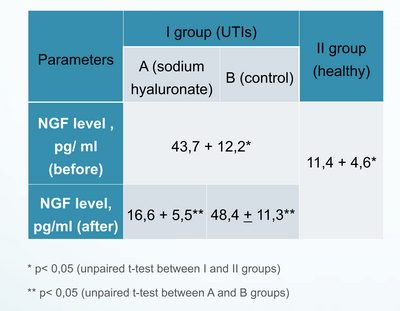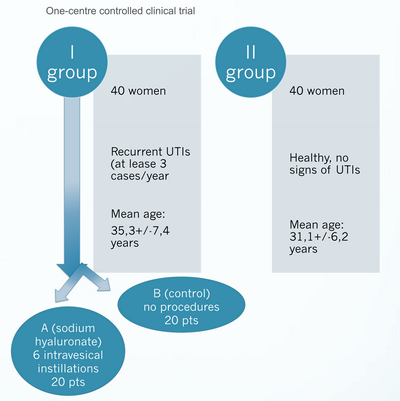Hypothesis / aims of study
The damage of GAG-layer of urothelium is one of most important causes of IC and recurrence bacterial cystitis. GAG – replacement therapy is promising method of treatment and prevention of these conditions. Unfortunately, indications for this therapy are no completely clear. Recently studies showed possible role of NGF, as biomarker of urothelium impairment. We’ve decided to evaluate NGF level in patients with recurrence bacterial cystitis and change of this level during GAG-replacement therapy.
Results

There was significant difference between 1st and 2nd group of patients. It can be associated with increased production NGF due impairment of urothelium. Also, there was significant difference between A and B subgroups. Intravesical administration of sodium hyaluronate is recovering the protective barrier of urothelium. Perhaps, it leads to decrease of NGF level.
Study design, materials and methods

NGF level was evaluated three times in the urine of each patient before study and mean value was used in study. Urine sample was 150 ml, it was spinning and supernatant was taken for study. After that, patients of 1st group were divided into two subgroups, A and B, 20 patients in each subgroup. Thereupon, patients of A subgroup have been taken six intravesical instillations of sodium hyaluronate (160 mg in 50 ml saline) – one instillation weekly. Patients of B subgroup didn’t receive any procedures. 2 month later, NGF was evaluated repeatedly.
Conclusion
NGF is promising biomarker for diagnosis of urothelium impairment and decision making of GAG-replacement therapy. Certainly, we need further investigations.
Mirkin Y (URO-PRO clinic) , Bedretdinova D (. Central Institute of Urology, Moscow) , Smirnov G (MKC Laboratories, Moscow) , Eizenakh I (NMT Bioresearch)








